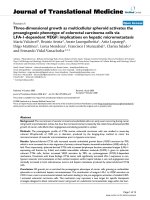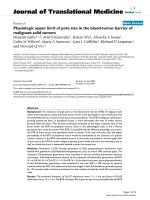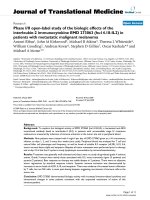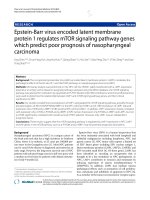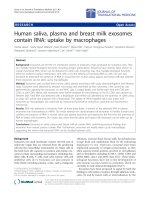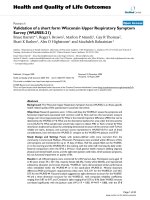báo cáo hóa học: " Pilose antler polypeptides promote chondrocyte proliferation via the tyrosine kinase signaling pathway" pdf
Bạn đang xem bản rút gọn của tài liệu. Xem và tải ngay bản đầy đủ của tài liệu tại đây (704.49 KB, 5 trang )
RESEARC H Open Access
Pilose antler polypeptides promote chondrocyte
proliferation via the tyrosine kinase signaling
pathway
Jian-Hua Lin
1
, Ling-Xiao Deng
1
, Zhao-Yang Wu
1
, Lei Chen
1
and Li Zhang
2*
Abstract
Background: Pilose antler polypeptides (PAP) have been reported to promote chondrocyte proliferation. However,
the underlying mechanism remains unclear. The present study was to investigate the effects of PAP on the
proliferation of chondrocytes and its underlyi ng mechanism.
Methods: Chondrocytes isolated from the knee of Zealand white rabbits were cultured. The second generation
chondrocytes were collected and identified using safranin-O staining. The chondrocytes were divided into the
following 4 groups including serum-free, PAP, genistein (an inhibitor of tyrosine kinases), and PAP plus genistein
group. Cell viability was analyzed using the MTT assay. The cell cycle distribution of the chondrocytes was analyzed
by flow cytometry. The expression levels of cyclin A was detected using immunocytochemical staining.
Results: No significant difference was observed between serum-free and genistein group. Treatment of the
cultures with PAP produced a significant dose-dependent increase in cell viability, the percentage proportion of
chondrocytes in the S phase and Cyclin A expression as well. However, the promoting effect of PAP on
chondrocyte proliferation were dose-dependently inhibited by genistein, whereas genistein alone had no effect on
proliferation of isolated chondrocytes.
Conclusions: The data demonstrate that PAP promotes chondrocyte proliferation with the increased cell number,
percentage proportion of chondrocytes in S phase and expression of protein cyclin A via the TK signaling pathway.
Keywords: PAP, Chondrocyte, Proliferation, S phase, Cyclin A, TK signaling pathway
Introduction
The facts that cartilage in deer antler grows at a rate of 1-
2 cm per day indicates that some specific regulatory fac-
tors in antler tis sues may play a key role in promoting
the proliferation of chondrocytes. Recently, pilose antler
polypeptides (PAP) were developedfromvelvetantler
(VA) of sika deer (Cervus Nippon Temminck), which
were found to promote chondrocyte proliferation [1].
However, its underlying mechanism remains obscure.
The proliferation of cells is well regulated by the inter-
actions of a variety of growth factors, cytokines, and sig-
nal molecules [2]. Protein kinases, particularly tyrosine
kinases (TK) have been charac terized as mo dulating cell
proliferation and differentiation [3]. Mitogen-activated
protein kinase activation is required for the ir role as
phosphorylating enzymes. These reports led to a
hypothesis that TK signaling pathway may be involved
in PAP inducing chondrocyte proliferation.
Genistein (4,7,4’ -trihydroxyisoflavone), a major isofla-
vone from soybean, has been proven as a specific inhibi-
tor of TK. Previous studies have confirmed that
genistein, which block kinase ATP-binding sites, specifi-
cally inhibit ph osphorylation of tyrosine residues, thereby
inhibiting cells growth [4,5]. As a result, high specificity
of genistein has been wide used to study for involvement
of tyrosine phosphorylation in cell proliferation.
Thepresentstudywastoelucidatetheeffectsof
PAP on the proliferation of chondrocytes and examine
the role of tyrosine phosphorylation in PAP mediating
chondrocyte proliferation by using genistein which
* Correspondence:
2
Orthopaedics & Traumatology College, Fujian University of Traditional
Chinese Medicine, Fuzhou, Fujian, PR China
Full list of author information is available at the end of the article
Lin et al. Journal of Occupational Medicine and Toxicology 2011, 6:27
/>© 2011 Lin et al; licensee BioMed Central Ltd. This is an Open Access article distributed under the terms of the Creative Commons
Attribution License ( which permits unrestricted use, distribution, and reproduction in
any medium, provided the original work is prope rly cited.
was expected to inhibit tyrosine phosphorylation in
the cell.
Materials and met hods
Chondrocytes culture and confirmation
The articular cartilages were harvested from the knees
joints of one-month-old New Zealand white rabbits
(Shanghai a nimal experimental center), and transferred
to phosphate- b uffered saline (PBS) with 500 units/ml
penicillin and 500 μg/ml streptomycin. Then the carti-
lages were cut into 1 mm pieces, and digested with
0.25% trypsin/EDTA (Sigma, St. Louis, MO, USA) for
0.5 h and 0.2% collagenase type II (Sigma, St. Louis,
MO, USA) subsequently. The isolated cells were col-
lected and counted every 2 hours. They were cultured at
a density of 1.5 × 10/ml in F12 culture medium (Sigma,
St. Louis, MO, USA) supplemented with 15% fetal calf
serum (FCS, Sijiqing Co., Hangzhou, China), and incu-
bated at 37°C i n a 5% CO2 incubator. Culture media
were changed every 3-4 days, and cells were passaged
every week, and the third passages of cells were used in
all experiments. After the third passage, cells were har-
vested and seeded on glass slice for 6 days, and observed
under microscopy for the production of glycosaminogly-
cans (GAG) after Safranin-O staining.
Experimental design
The cultured chondrocytes were divided randomly into
4 groups: control group, PAP (provided by New Drug
Research Center in the Affiliated Hospital of Chang-
chun College of Traditional Chinese Medicine.) group,
Genistein (Sigma, St. Louis, MO, USA) group, and
PAP + Genistein group. In cont rol group, chondro-
cytes were cultured with serum-free culture medium
only. In PAP group, chondrocytes were cultured with
additional PAP at different concentrations, i.e. 0 μg/ml,
12.5 μg/ml, 25.0 μg/ml, 50.0 μg/ml, and 100 μg/ml,
respectively. In Genistein group, cells were cultured in
medium plus Genistein at 0 μg/ml, 6 μg/ml, 12 μg/ml,
24 μg/ml, and 48 μg/ml. In PAP + Genistein group,
cells were cultured with 50.0 μg/ml PAP, as well as
Genistein of 0 μg/ml, 6 μg/ml, 12 μg/m l, 24 μg/ml,
and 48 μg/ml, respectively.
MTT assay
Chondrocytes at passage 2 were seeded into 96-well
plates at a density of 1 × 104/ml. When cells reached
80% confluences, they were switch to serum-free media
for 24 hours. Then 1 00 μl agent was added into each
well with serum-free media, PAP, and Genistein at dif-
ferent concentrations as mentioned above. 48 hours
later, 20 μlof5g/L(w/v)MTT(Sigma,St.Louis,MO,
USA) was added into each well. The cells were
incubated for further four hours. Then the supernatant
was removed, and 150 μl/well of dimethyl sulphoxide
(DMSO) were added to dissolve the formazane. Absor-
bance was measured at a major wavelength of 570 nm
and a reference wavelength of 690 nm with a Reder’s
plate reader (Reder, Japan) [6]. OD value was obtained
for each well.
Determination of Proliferation by Flow Cytometry
Chondrocytes at passage 2 were seeded into 60 mm cul-
ture dishes at a density of 1 × 104/ml and cultured to
logarithmic growth phase. Then the cells were switched
to serum free F12 culture medium for 24 hours. After
that, cells were divided into three groups which serum-
free media, 50 μg/ml PAP, and 50 μg/ml PAP plus 48
μg/ml Genistein were added into each group respec-
tively. The PAP should be added 30 minutes after the
addition of Genistein which were kept in warm water.
Cells were collected 48 hours later, and their densities
were adjusted to 105/ml before they were fixed in 75%
cold ethanol and incubated at 4°C overnight. The next
day, cells were stained by propidium iodide containing
100 mg/ml RNase A before flow cytometric analysis [7].
Cyclin A Immunocytochemistry
Chondrocytes at passage 2 and 3 at a density of 1 ×
106/ml were seeded onto glass slices, which were put
inside 6-well plate. 12 hours later when all cells were
fully attached on the slices, different cultured media
including regular culture media, PAP, PAP with Geni-
sein at different concentrations were added and cultured
for 48 hours followed standard immunocytochemical
staining procedure. Afterwards, the slides were treated
for 15 min in 0.1% Triton X-100 in PBS, ri nsed in PBS,
fixed for 1 min in -20°C acetone (analysis grade) , and
the sections were rehydrated in PBS containing 0.5%
BSA (BSA-PBS). Then the sections were incubated over-
night at room temperature with anti-cyclin A antibody
diluted 1:100 in PBS-BSA. Fluorescent photomicro-
graphs were taken from five randomly chosen and no
overlapping fields of the cyclin A-stained sections. A
total of 1000 nuclei were counted per slice. The number
of cyclin A positive nuclei were counted, and the posi-
tive rate was calculated. Mouse anti-rabbit cyclin A
monoclonal antibody, sheep anti-mouse secondary anti-
body, and DAB kits were obtained from Boside Co.
(Wuhan, China).
Statistical analysis
Data are expressed as mean ± standard deviation (SD).
One-way ANOVA was used for statistical comparison of
the means by using SPSS statistical software. Statistical
significance was set at the P < 0.05 level.
Lin et al. Journal of Occupational Medicine and Toxicology 2011, 6:27
/>Page 2 of 5
Results
Confirmation of chondrocytes
Chondrocytes were validated by GAG immunologic test.
They were stained as blue by Safranin-O staining and
proved to be chondrocytes (Figure 1).
Effects of PAP and Genistein on the proliferation of
chondrocytes
Compared to the control group, the addition of PAP
significantly increased the OD values w ith a dose
depended manner (Figure 2). The higher concentration
of PAP a dded, the higher OD value were observed.
Since the OD value represent the number of chondro-
cytes, the increased OD values indicated that the addi-
tion of PAP significantly increased the number of
cultured chondrocytes. H owever, the addition of
different concentrations of Genistein had no effect on
OD values (Figure 3), indicating that Genistein itself had
no effect on the proliferation of chondrocytes.
Genistein inhibited the promoting effect of PAP on
chondrocytes proliferation
When different c oncentrations of Genistein were pre-
sented, the addition of PAP (50 μg/ml) resulted in a
decreased OD values (Figure 4). The more Genistein
presented, the lower OD values were detected, which
indicated that Genistein suppress the promoting effect
of PAP on chondrocytes proliferation at a dose related
manner. When the concentration of Genistein reached
and beyond 24 μg/ml, the OD values detected were
Figure 1 The GAG expression in rabbit cartilage by Alcian blue
staining (×600).
Figure 2 The effect of Antler polypeptides on the proliferation
of chondrocytes. Compared to the control group, the addition of
PAP significantly increased the OD values with a dose depended
manner. *: P < 0.05, **: P < 0.01.
Figure 3 The effect of Genistein on the proliferation of
chondrocytes. Compared to the control group, the addition of
different concentrations of Genistein had no effect on the
measurement of OD values.
Figure 4 Effect of Genistein on the promoting effect of PAP on
chondrocytes proliferation. In addition of PAP, the addition of
different concentrations of Genistein significantly reduced the OD
values. *: P < 0.05, **: P < 0.01.
Lin et al. Journal of Occupational Medicine and Toxicology 2011, 6:27
/>Page 3 of 5
reduced to a very low level similar to that in control
group (Figure 3), which means 24 μg/ml of Genistein
could fully suppress the promoting effect of PAP on
chondrocytes proliferation.
PAP increased chondrocytes proliferation in S phase
Since the amount of DNA in cells can be measured by
flow cytometry, this test was used to identify the pro-
portions of cells i n different parts of the cell cycle (the
growth cycle of a cell). In this study, chondrocytes on
different phases were detected using flow cytometry
under different conditions, namely, in serum-free med-
ium, with PAP, and with PAP + Genistein. Compared to
control group, the mean proportion of cells in S phase
increased sharply from 6.4% (Figure 5a) to 35.2% (Figure
5b) after adding PAP. However, when Genistein was
present, the proportion of cells in S phase was dramati-
cally dropped to 4.0% (Figure 5c). This result indicates
that Genistein suppress the promoting effect of PAP
mainly in S phase.
PAP increased the cyclin A expression in chondrocytes
In control group, the cyclin A e xpression were found in
one tenth of all cells, however, the cyclin A expression
increased to 50% after adding PAP (50 μg/ml, Figure 6,7).
Discussions
This report provides mechanistic insights into the pro-
mot ing effects of PAP on chondrocyte proliferation and
implicates the involvement of TK-signaling pathway.
The proliferation of chondrocytes was evaluated directly
with MTT assay, and indirectly by assessing cell cycle
distribution and cyclin A expression levels when stimu-
lated with PAP. And the involvement of TK-signaling in
PAP mediating chondrocyte p roliferation was identified
with the treatment of genistein.
No significant difference in MTT assay, FCM or expres-
sion levels of cycling A were found between serum-free
and genistein group. Indeed, the present results did not
prov ide the evidence that genistein showed an inhi bitory
effect on the cultured chondrocytes with serum-free med-
ium, suggesting that TK pathway may not be required for
isolated chondrocyte proliferation.
PAP promoted chondrocyte proliferation
With the addition of PAP, MTT assay revealed that a
significant increase in number of chondrocytes com-
pared to the serum-free cultures. Similar results have
been reported by others [8]. Moreover, FCM found the
significantly increased percentage proportion of chon-
drocytes in the S phase, indicating that PAP may
Figure 5 The effect by Antler polypeptides plus Genistein on proliferation of rabbit cartilage observed by Flow cytometry. A, the mean
proportion of cells in S phase were 6.4% in control group; B, the mean proportion of cells in S phase increased to 35.2% after adding PAP; C,
when Genistein was present, the proportion of cells in S phase was dramatically dropped to 4.0%.
Figure 6 The expression of Cyclin A by SABC immunostaining (×400). A, the cyclin A expression were quite few in control group; B, nearly
half of the cells express cyclin A after the addition of PAP (50 μg/ml).
Lin et al. Journal of Occupational Medicine and Toxicology 2011, 6:27
/>Page 4 of 5
accelerated S-phase entry and promote chondrocytes
cell cycle progression [9]. Also, chondrocytes cultured
with PAP exhibited a significant upregulation of cyclin
A expression, which was consistent with the increasing
percentage proportion of chondrocytes in the S phase
from FCM. Since the level of cyclin A correlates directly
with the proliferative state of cells [10], the data sup-
ported the hypothesis that the chondrocyte proliferation
was significantly enhanced by PAP. In addition, the pro-
gressive increases in cell number, perc entage of cells in
S-phase and cy clin A expression levels were ob served as
the concentration of PAP increased from 12.5 to 100
ug/m, suggesting PAP may promote chondrocyte prolif-
eration in a dose-dependent manner.
Genistein inhibited the promoting effect of PAP on
chondrocytes proliferation
Comparing with PAP group, there was a significant
decrease in cell number in MTT assess, the percentage
of cells in S-phase as well as expression levels of cyclin
A in PAP plus genistein group, indicating that t he pro-
moting effects of PAP on isolated c hondrocytes prolif-
eration were reversed by the specific TK inhibitor
genistein. Interestingly, genistein alone has no inhibitory
effect on chondrocyte proliferation. Furthermore, pro-
gressive decreases in cell number, percentage of cells in
S-phase and cyclin A expression levels were observed
when the concentration of genistein increased from 6 to
24 μg/ml, demonstrating that genistein inhibited the
promoting effect of PAP on chondrocyte proliferation in
a dose-dependent manner. Taken together, it is reason-
able to suggest that PAP promotes chondrocyte prolif-
eration by TK-mediated signaling. Future experiment
will be focused on the downstream signal pathway of
TK and its regulatory mechanism(s).
Conclusions
Our results demonstrate that chondrocyte proliferation
stimulated by PAP results in an increased in the number
of chondrocytes, the percentage proportion of cells in
the S phase and expression of protein Cyclin A via the
TK signaling pathway. Taking together, PAP promotes
chondrocyte proliferation by activating TK signaling
pathway.
Acknowledgements
This study was supported by New Century 100 Million Support Scheme of
China (No. [2009] 189).
Author deta ils
1
Department of Orthopaedics, First Affiliated Hospital of Fujian Medical
University, Fuzhou, Fujian, PR China.
2
Orthopaedics & Traumatology College,
Fujian University of Traditional Chinese Medicine, Fuzhou, Fujian, PR China.
Authors’ contributions
JHL carried out guarantor of integrity of the entire study; LZ carried out
manuscript review; LXD carried out the molecular genetic studies,
participated in the sequence alignment and drafted the manuscript; ZYW
carried out statistical analysis; LC carried out immunoassays; All authors read
and approved the final manuscript.
Competing interests
The authors declare that they have no competing interests.
Received: 9 June 2010 Accepted: 10 November 2011
Published: 10 November 2011
References
1. Allen SP, Maden M, Price JS: A role for retinoic acid in regulating the
regeneration of deer antlers [J]. Dev Biol 2002, 251(2):409-423.
2. Kitoh H, Ishiguro N: [Molecular mechanism in the differentiation of
chondrocytes] [J]. Clin Calcium 2007, 17(4) :493-498.
3. Malemud CJ: Protein kinases in chondrocyte signaling and osteoarthritis
[J]. Clin Orthop Relat Res 2004, 427(Suppl):S145-151.
4. Bian ZM, Elner SG, Elner VM: Regulation of VEGF mRNA expression and
protein secretion by TGF-beta2 in human retinal pigment epithelial cells
[J]. Exp Eye Res 2007, 84(5):812-822.
5. Akiyama T, Ishida J, Nakagawa S, et al: Genistein, a specific inhibitor of
tyrosine-specific protein kinases [J]. J Biol Chem 1987, 262(12):5592-5595.
6. Shen Y, Li SM, Tang Y, et al: Effect of basic fibroblast growth factor and
hyaluronic acid on proliferation of rabbit chondrocytes in vitro [J]. Chin J
Traumatol 2004, 7(1):42-44.
7. Seemayer CA, Kuchen S, Kuenzler P, et al: Cartilage destruction mediated
by synovial fibroblasts does not depend on proliferation in rheumatoid
arthritis [J]. Am J Pathol 2003, 162(5):1549-1557.
8. Chen XD, Lin JH: [Role of pilose antler polypeptides on replicative
senescence of rat chondrocyte [J]. Zhongguo Gu Shang 2008,
21(7):515-518.
9. Wilsman NJ, Farnum CE, Green EM, et al: Cell cycle analysis of proliferative
zone chondrocytes in growth plates elongating at different rates [J]. J
Orthop Res 1996, 14(4):562-572.
10. Celis JE, Bravo R, Larsen PM, et al: Cyclin: a nuclear protein whose level
correlates directly with the proliferative state of normal as well as
transformed cells [J]. Leuk Res 1984, 8(2):143-157.
doi:10.1186/1745-6673-6-27
Cite this article as: Lin et al.: Pilose antler polypeptides promote
chondrocyte proliferation via the tyrosine kinase signaling pathway.
Journal of Occupational Medicine and Toxicology 2011 6:27.
Figure 7 The expression of Cyclin A by immuno-staining SABC.
Compared to the control group, the addition of PAP significantly
increased the expression of Cyclin A. **: P < 0.01.
Lin et al. Journal of Occupational Medicine and Toxicology 2011, 6:27
/>Page 5 of 5

